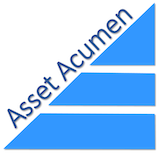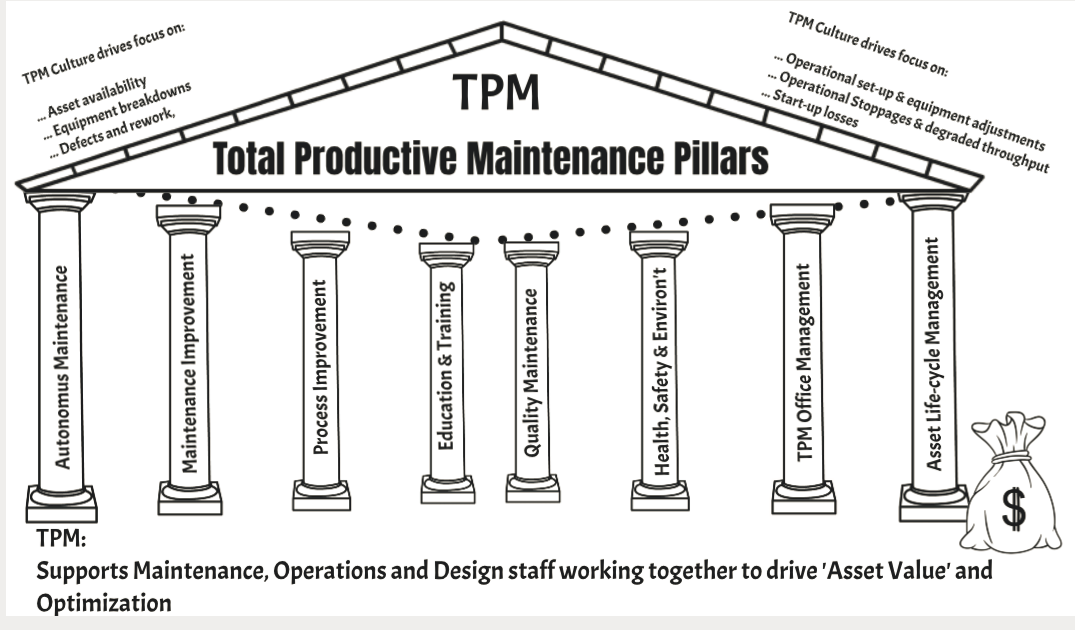What is Total Productive Maintenance (TPM) today?
TPM can be foundationally called – ‘Reliability’ by Operator! Today – It is often a lost cultural focus in many North American operations. Leadership can help this!
Total Productive Maintenance (TPM) is a highly powerful working philosophy and part of an organization’s culture for managing maintenance, operations and engineering in a plant environment. It harnesses the power of the entire workforce to increase the productivity of the company’s physical assets, optimizing man / machine interaction.
I have observed it more often as a foundational culture of a maintenance organization in the Pacific Rim countries than in North America but it exists everywhere at some level.
One way to recognize a TPM culture is in place, is to observe the level in which it is recognized that maintenance and operations staff habitually support each other.
Evidence of a TPM culture being in place can include:
- Leaders regularly discuss performance and costs with their work team;
- Weekly and Monthly operational (production) reviews are facilitated with both Maintenance and Operational personnel are actively contributing;
- Participative organization where decisions are made at the lowest effective level;
- Empowered and self-directed Operator, Maintenance, and Engineering Work Teams perform much of the work;
- Operators, perform minor maintenance activities;
- Multi-skilled trades people are a feature of the organization:
- i.e. Electricians doing minor mechanical work, mechanics doing minor electrical work;
- Partnerships established with key suppliers and contractors; and
- Continuous improvement teams are in place and active.

6 S concepts are not new!
Perhaps the simplest way to describe TPM is to suggest that it is an extension of Total Quality Management (TQM) but with a focus on asset maintenance that requires cross functional departments to work together for a common outcome. TPM promotes activities of the operator to conduct some of maintenance activities, including cleaning, lubricating, retightening, and inspection, thereby raising production efficiency to its limit.
A formal TPM program will have some evidence of a formal set of supporting functions including:
|
|

Each of these TPM functional elements -when managed earnestly – can take up a significant amount of focus time training the enterprise culture into recognizing that they are all working towards the same goals of driving ‘business value’ and with that ‘asset value’. At another time, I can expand each of these in detail but –
Recognize that TPM is ‘not’ just a short ‘team meeting’ or ‘team training’ where, when done you can expect to have “answered the mail” on the TPM culture development in your organization.
You will need to train or folks on multiple areas– including on the notion of a TPM program – to expect to be successful.
Recognize that TPM is:
- a multi seasonal program that requires commitment by the leadership and staff (maintenance, operations and design engineering) to work together to ensure asset value;
- a program that leverages focused initiatives for Process Improvementthat -for example- could include:
- Plan, Do, Check, and Act;
- 6S program ‘SORT OUT, SET IN ORDER, SHINE, STANDARDIZE, SUSTAIN, SAFETY’;
- new changes to Enterprise asset Management (EAM), Asset Performance management (APM) and/or Asset Investment Planning (AIP) solutions.
- a program of Autonomous Maintenancethat gets production workers supporting asset maintenance by being genuinely involved in equipment care, working with maintenance to stabilize conditions and stop accelerated deterioration.
- a Maintenance Improvementprogram that establishes baselines and measures progress, prioritizes equipment issues and initiatives, leverages available data and drives a culture of continuous improvement. Overall Equipment Effectiveness (OEE) metrics could play a key role in tracking progress here.
- Education and Trainingprograms that ensure that the staff have the training they need in their culture for: Inspections, Root Cause Analysis, Process assessments and analysis and feedback mindsets, equipment technical elements they may be exposed to and related health, safety and environment training. Ideally individual ‘skill assessment and development plans’ are systemically managed and prioritized for each member of the team.
- Quality Maintenanceprograms that aim at eliminating quality issues and then more formally assess, analyze and implement improvements.
- Asset Life-cycle Managementprograms that focus on early equipment issues, goals and output service levels but is tenacious about the program support needed throughout an asset’s life (i.e. parts stocking policy, staff training, equipment end of life issues).
- Health, Safety and Environment (HSE)tracking and support that tracks the root cause of previous issues and is proactive in their support for prevention of potential issues.
- TPM Office Management can be an oversight program for the above TPM elements and often takes the above cultural disciplines into the office environment as well.
While TPM does empower the staff to drive ‘asset value,’ the organizations‘leadership’ will need to be seen leading the TPM programsupport if they expect the staff to sustain any interest in keeping such a focus going.
Implementing a TPM program as a formal culture set can be done in phases. Perhaps annually (or seasonally). Typical TPM phases can be:
- Establish acceptable equipment operating conditions to stabilize reliability;
- Lengthen asset life;
- Optimize asset conditions; and then
- Optimize life cycle cost.
The fundamentals should continue and expand as you implement the four phases.
TPM creates an ‘ownership’ cultural where every member of staff should believe that they ‘make a difference’ and do contribute to the enterprise’s success. The tangible benefitsof a TPM culture can be:
- Reduced process defects, interruptions and waste;
- Energy conservation;
- Increased asset productivity;
- Reduced maintenance and production costs;
- Improved early warning of maintenance issues;
- Engaged operators in set-ups and asset adjustments;
- Improved understanding of equipment issues and mitigation;
- Improved standards for job safety and asset reliability;
- Higher customer satisfaction (due to met delivery commitments); and
- Increase equipment capacity.
There are also in-tangible benefits of a TPM program, including:
- Higher levels of employee empowerment, engagement and satisfaction;
- Reduced safety issues;
- Improved employee ‘ownership’ to their equipment production results;
- Employee participation in business results and feeling of contribution;
- Diverse job skill development and application;
- Improved sustainment of clean, structured and attractive workplace;
- Team collaboration and ownership in business results;
- Improved employee acumen through training and skills development;
- Many maintenance measures can be managed by the operator directly;
Typically, we all come to work wanting to contribute to the value of the organization we serve.
Today – Embedding a driven TPM culture and program provides a structure and training set that will empower your organization to do just that. TPM may not we a simple task but the benefits are real and self-sustaining.

What is your TPM Roadmap?

